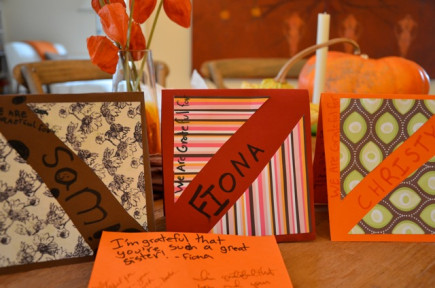
“Abundance can be had simply by consciously receiving what has already been given.” —Sufi Saying
As a “happiness expert” (as I’m sometimes called), people often ask me, “If you had to pick just one thing that could make me happier right now, what would it be?”
I’m always tempted to make jokes about sex and yoga—or maybe a glass of wine.
Glib responses aside, those of us who teach happiness for a living have some ready answers to this question. Sonja Lybomirsky, author of The How of Happiness, picks exercise as the best instant happiness booster. Martin Seligman, author of Authentic Happiness and Flourishing, recommends acts of kindness.
Knowing the research, I’m sold on the happiness-boosting properties of both exercise and kindness. But I have a different #1.
I believe gratitude is the foundation of personal happiness—and a community’s happiness as well, as the two aren’t easily separated.
If we want to be happy, and to raise happy kids, we need to practice gratitude— deliberately, and consistently, or we may end up feeling more entitled than appreciative.

When we feel entitled, we often stew about unfulfilled expectations. Entitlement makes us more likely to feel disappointed when we don’t get what we think we want, rather than grateful when we receive something.
Disappointment is not a happiness habit. Gratitude is.
Habit being the key word: We need to establish rituals and traditions that make feeling and expressing gratitude habitual. Here are three of my favorite gratitude practices.
1. On Thanksgiving, we appreciate each other by writing on our dinner table place cards. The kids make giant construction paper placecards for each guest, and as people arrive and mingle, we each take some time to sit down at the table and write on the inside of each place card something that we love or appreciate about them. (If you are reading this post via email, you can see images of these placecards here. I also describe this practice more in this podcast.)
2. Several times a week, I take a photograph of something I find beautiful or inspiring, or something for which I feel grateful. I was inspired to do this by Hailey Bartholomew’s film. Often, I just take the photo with my phone, and usually it never gets shared.
3. Everyday, I ask my kids about three good things. They might share good things that happened to them that day, or good things they did themselves, or even something good that hasn’t happened yet that they are anticipating. For example: “One good thing today is that in two days we get to go to Chico to see Grammy & Grampa Snuggles and our cousins!” They are counting their blessings.
We do this practice in all different circumstances. Sometimes it’s while snuggled in bed. Sometimes, when I have a speaking engagement at night, we do it after school, on the couch. Sometimes it’s over the phone if they’re at their dad’s house. But no matter the situation, their first good thing is always “right now.” This reminds me to be present and recognize that this particular “right now” is worthy of great gratitude.
In addition to stirring up feelings of gratitude (while curbing a sense of entitlement), all of these practices evoke the positive emotions that make us feel deeply satisfied with our lives.
The first practice makes us feel loved, and helps us express the love we have for others.
The second makes me feel awe and elevation, because I’m usually photographing something beautiful in nature. I will also often also feel love if there is, say, a child in the picture. And sometimes I just feel awash in contentment and peace—or creativity and inspiration—as I take the photograph.
The third practice can evoke a full range of positive emotions: anticipation and excitement (about something coming up); kindness and compassion (for someone they did a “good thing” for); straight-up relived happiness (recounting a fun time at recess).
All of these practices evoke the abundance that is all around us, even in these challenging times. As the Sufi saying above acknowledges, they help us receive the many gifts that are already out there.
What are your family’s favorite gratitude practices?
—-
© 2011 Christine Carter, Ph.D.
Become a fan of Raising Happiness on Facebook.
Follow Christine Carter on Twitter
Sign up for the Raising Happiness monthly newsletter.


Comments